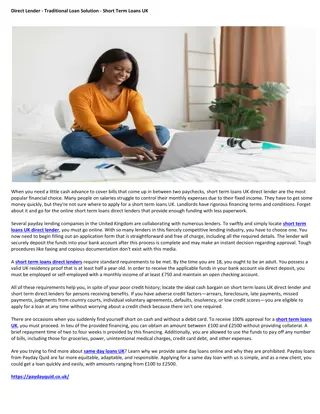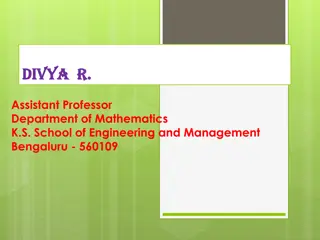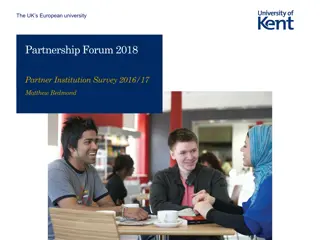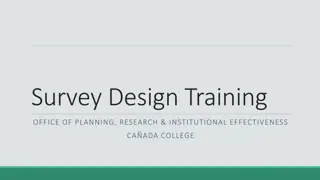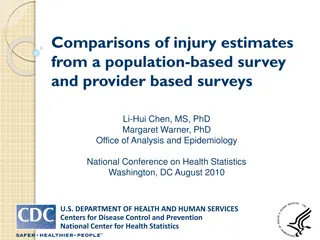Introduction to Complex Survey Data Analysis Short Course
This short course on complex survey data analysis covers topics such as types of survey data, probability vs. non-probability sampling, complex sampling designs, and examples with hands-on practice. It delves into SAS code templates, searching for design information, and real data analysis techniques, with a focus on understanding and analyzing survey data effectively. The course also discusses the NHANES and BRFSS surveys as examples of probability sampling designs.
Download Presentation

Please find below an Image/Link to download the presentation.
The content on the website is provided AS IS for your information and personal use only. It may not be sold, licensed, or shared on other websites without obtaining consent from the author.If you encounter any issues during the download, it is possible that the publisher has removed the file from their server.
You are allowed to download the files provided on this website for personal or commercial use, subject to the condition that they are used lawfully. All files are the property of their respective owners.
The content on the website is provided AS IS for your information and personal use only. It may not be sold, licensed, or shared on other websites without obtaining consent from the author.
E N D
Presentation Transcript
Introduction to Complex Survey Data Analysis Sixia Chen, PhD OSCTR Novel Methodological Unit Short Course 4/7/2023
Course Material https://osctr.ouhsc.edu/short-course
Outline Introduction to Complex Survey Data SAS code templates Searching design information for real data analysis Examples with hands-on practice Q&A
Types of survey data Probability sample: Each unit in the population has non-zero probability of being selected in the sample Non-probability sample (Convenience sample): Not every unit in the population has non-zero probability of being selected in the sample
Probability sample VS Non-probability sample Measure\Type of Survey Prob Non-Prob Selection Bias Small Large Representativeness High Low Cost High Low Time Long Short Lack of Frame Survey Impossible Possible
Complex Survey Data Data collected by using complex sampling designs (Prob or Non-Prob) Commonly used probability sampling designs Simple random sampling with/without replacement Stratified sampling Multi-stage sampling design Probability proportional to size sampling design Two-Phase sampling Multi-Frame sampling design
Probability Sample -NHANES Four year National Health and Nutrition Examination Survey (NHANES): stratified multi-stage complex sampling design Sample design: Draw stratified systematic PPS sample of 60 counties from US Within each selected county, draw independent segment sample by using stratified systematic PPS Within each selected segment, draw systematic sample of households Within each selected household, draw people randomly Oversampling of certain groups such as older people, Asians and so on NHANES has clustering, stratification, PPSWOR and oversampling
Probability Sample - BRFSS The Behavioral Risk Factor Surveillance System (BRFSS) is the nation s premier system of health-related telephone surveys that collect state data about U.S. residents regarding their health-related risk behaviors, chronic health conditions, and use of preventive services BRFSS is one stage stratified random digit dialing telephone survey Independent sampling for each of the 50 states in US BRFSS divides telephone numbers into two groups, or strata, which are sampled separately. The high-density and medium-density strata contain telephone numbers that are expected to belong mostly to households
Non-Probability Sample - Example 2019 Tribal Behavioral Risk Factor Surveillance System conducted by Tribal Epidemiology Center Target population: American Indian Adults who lived in OK, KS, TX Sampling design: Tribal event sampling Email sampling Social media sampling Sample size improved from about 300 in 2015 to about 800 in 2019
Weighting Complexity - Reasons Design complexity Nonresponse complexity: unit nonresponse and item nonresponse Decreasing MSE: ratio estimation (calibration) and trimming Variance estimation complexity Statistical disclosure control complexity
Weighting Complexity - Components Design base weight Nonresponse adjustment Imputation Ratio estimation (raking or calibration) Trimming Variance estimation Statistical disclosure control
Sampling weights General formula FW=BW NRA CA TRA where each term is defined as following: FW: final sampling weight BW: design base weight NRA: nonresponse adjustment factor CA: calibration (ratio or raking) adjustment factor TRA: trimming adjusted factor
Design features for Statistical Analysis Final sampling weight First Stage Stratification (Stratum or Pseudo Stratum) First Stage Clustering (Primary Sampling Unit (PSU) or Pseudo PSU) Replication weights (Optional, For variance estimation purpose)
SAS code Descriptive Statistics for Continuous Variables proc surveymeans data=indat; var var1 var2 var3; weight finalwt; /*final sampling weight*/ domain var4; /*subgroup analysis*/ strata st; /*Stratification variable*/ cluster psu; /*Clustering variable*/ run;
SAS code Descriptive Statistics for Categorical Variables proc surveyfreq data=indat; /*input data file*/ tables var1 var2 var3; weight finalwt; /*final sampling weight*/ domain var4; /*subgroup analysis*/ strata st; /*Stratification variable*/ cluster psu; /*Clustering variable*/ run;
SAS code Binary Association Analysis for Continuous Dependent Variable proc surveyreg data=indat; class var2; /*If var2 is categorical variable*/ model var1=var2; /*var1 is dep var, var2 is indep var*/ weight finalwt; /*final sampling weight*/ strata st; /*Stratification variable*/ cluster psu; /*Clustering variable*/ run; /*Note that two sample t test can be done by using dummy variable (1/0) for var2*/
SAS code Binary Association Analysis for Categorial Variables proc surveyfreq data=indat; /*input data file*/ tables var1*(var2 var3) /row CL chisq; weight finalwt; /*final sampling weight*/ domain var4; /*subgroup analysis*/ strata st; /*Stratification variable*/ cluster psu; /*Clustering variable*/ run; /*Need to use Rao-Scott Chi-square test instead of traditional Chi- square test*/
SAS code Multivariate logistic regression proc surveylogistic data=indat; class var1 var2 var3; /*specify categorical variables*/ model var1=var2 var3 var4; /*var1 is dep var, others are indep vars*/ weight finalwt; /*final sampling weight*/ strata st; /*Stratification variable*/ cluster psu; /*Clustering variable*/ run;
SAS code Multivariate linear regression proc surveyreg data=indat; class var1 var2 var3; /*specify categorical variables*/ model var1=var2 var3 var4; /*var1 is dep var, others are indep vars*/ weight finalwt; /*final sampling weight*/ strata st; /*Stratification variable*/ cluster psu; /*Clustering variable*/ run;
SAS code Cox regression proc surveyphreg data=indat; class var1 var2 var3; /*specify categorical variables*/ model mortality*death(0)=var1 var2 var3 var4; /*mortality is survival time, death is censoring indicator, others are predictors*/ weight finalwt; /*final sampling weight*/ strata st; /*Stratification variable*/ cluster psu; /*Clustering variable*/ run;
Model selection SAS macro for backward, forward, and stepwise model selection: https://www.norc.org/PDFs/CESR%20Docs/MWSUG-2011-SA02.pdf Manual backward model selection
Searching design information for data analysis National Health and Nutrition Examination Survey (NHANES) The Behavioral Risk Factor Surveillance System (BRFSS) National Health Interview Survey (NHIS)
Example NHANES 2017-2018 NHANES data: https://wwwn.cdc.gov/nchs/nhanes/continuousnhanes/default.aspx? BeginYear=2017 We consider the following data files: Demographics data (Age, Gender, Race, etc.) Examination data (Blood pressure, Body measure) Laboratory Data (Total Cholesterol) Design features: Final weight, Stratification, and Clustering
Research Question and Variables RQ: What is the association between Total Cholesterol and other predictors? Dependent variable: Total Cholesterol Predictors: Age, Gender, Race, Education, Income, Household Size, Marital Status, BMI, Blood Pressure (Diastolic and Systolic) Design variables: final weight, stratification variable, clustering variable Removed all the missing values
Unweighted Descriptive Statistics proc means nmiss min P50 mean max std maxdec=2 data=comb2; var BMXBMI BPXDI1 BPXSY1 RIDAGEYR; run; proc freq data=comb2; tables DMDEDUC2 DMDHHSIZ DMDMARTL INDHHIN2 RIAGENDR RIDRETH1 /missing list; run;
Weighted Descriptive analysis proc surveymeans nmiss mean sum median std data=comb2; var BMXBMI BPXDI1 BPXSY1 RIDAGEYR LBXTC; weight WTMEC2YR; strata SDMVSTRA; cluster SDMVPSU; run;
Weighted Descriptive analysis (2) proc surveyfreq data=comb2; tables DMDEDUC2 DMDHHSIZ DMDMARTL INDHHIN2 RIAGENDR RIDRETH1; weight WTMEC2YR; strata SDMVSTRA; cluster SDMVPSU; run;
Binary Association Analysis proc surveyreg data=comb2; model LBXTC=BMXBMI; weight WTMEC2YR; strata SDMVSTRA; cluster SDMVPSU; run;
Binary Association Analysis (10) proc surveyfreq data=comb2; tables LBXTC2*(DMDEDUC2 DMDHHSIZ DMDMARTL RIAGENDR RIDRETH1) /row CL chisq; weight WTMEC2YR; strata SDMVSTRA; cluster SDMVPSU; run; /*Note that LBXTC2=0 if LBXTC2<188 and 1 otherwise*/
Multivariate linear regression for LBXTC proc surveyreg data=comb2; class DMDMARTL RIAGENDR RIDRETH1; model LBXTC=BPXDI1 BPXSY1 DMDHHSIZ DMDMARTL RIAGENDR RIDRETH1/solution; weight WTMEC2YR; strata SDMVSTRA; cluster SDMVPSU; run;
Multivariate logistic regression for LBXTC2 proc surveylogistic data=comb2; class DMDMARTL RIAGENDR; model LBXTC2=BPXDI1 BPXSY1 DMDHHSIZ DMDMARTL RIAGENDR; weight WTMEC2YR; strata SDMVSTRA; cluster SDMVPSU; run;






